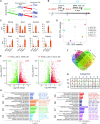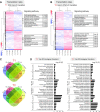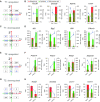Regulation of both transcription and RNA turnover contribute to germline specification
- PMID: 35776114
- PMCID: PMC9303369
- DOI: 10.1093/nar/gkac542
Regulation of both transcription and RNA turnover contribute to germline specification
Abstract
The nuanced mechanisms driving primordial germ cells (PGC) specification remain incompletely understood since genome-wide transcriptional regulation in developing PGCs has previously only been defined indirectly. Here, using SLAMseq analysis, we determined genome-wide transcription rates during the differentiation of embryonic stem cells (ESCs) to form epiblast-like (EpiLC) cells and ultimately PGC-like cells (PGCLCs). This revealed thousands of genes undergoing bursts of transcriptional induction and rapid shut-off not detectable by RNAseq analysis. Our SLAMseq datasets also allowed us to infer RNA turnover rates, which revealed thousands of mRNAs stabilized and destabilized during PGCLC specification. mRNAs tend to be unstable in ESCs and then are progressively stabilized as they differentiate. For some classes of genes, mRNA turnover regulation collaborates with transcriptional regulation, but these processes oppose each other in a surprisingly high frequency of genes. To test whether regulated mRNA turnover has a physiological role in PGC development, we examined three genes that we found were regulated by RNA turnover: Sox2, Klf2 and Ccne1. Circumvention of their regulated RNA turnover severely impaired the ESC-to-EpiLC and EpiLC-to-PGCLC transitions. Our study demonstrates the functional importance of regulated RNA stability in germline development and provides a roadmap of transcriptional and post-transcriptional regulation during germline specification.
© The Author(s) 2022. Published by Oxford University Press on behalf of Nucleic Acids Research.
Figures






Similar articles
-
Enhancer-associated H3K4 methylation safeguards in vitro germline competence.Nat Commun. 2021 Oct 1;12(1):5771. doi: 10.1038/s41467-021-26065-6. Nat Commun. 2021. PMID: 34599190 Free PMC article.
-
Induction of dedifferentiated male mouse adipose stromal vascular fraction cells to primordial germ cell-like cells.Cell Biol Int. 2014 Sep;38(9):1069-75. doi: 10.1002/cbin.10305. Epub 2014 May 19. Cell Biol Int. 2014. PMID: 24803313
-
Reconstitution of the mouse germ cell specification pathway in culture by pluripotent stem cells.Cell. 2011 Aug 19;146(4):519-32. doi: 10.1016/j.cell.2011.06.052. Epub 2011 Aug 4. Cell. 2011. PMID: 21820164
-
Germline specification from pluripotent stem cells.Stem Cell Res Ther. 2022 Feb 21;13(1):74. doi: 10.1186/s13287-022-02750-1. Stem Cell Res Ther. 2022. PMID: 35189957 Free PMC article. Review.
-
Mechanism and Reconstitution In Vitro of Germ Cell Development in Mammals.Cold Spring Harb Symp Quant Biol. 2015;80:147-54. doi: 10.1101/sqb.2015.80.027425. Epub 2015 Dec 7. Cold Spring Harb Symp Quant Biol. 2015. PMID: 26642855 Review.
Cited by
-
Progression of the pluripotent epiblast depends upon the NMD factor UPF2.Development. 2022 Nov 1;149(21):dev200764. doi: 10.1242/dev.200764. Epub 2022 Nov 7. Development. 2022. PMID: 36255229 Free PMC article.
-
Cell type- and factor-specific nonsense-mediated RNA decay.Nucleic Acids Res. 2025 May 10;53(9):gkaf395. doi: 10.1093/nar/gkaf395. Nucleic Acids Res. 2025. PMID: 40366162 Free PMC article.
-
Decay drives RNA abundance regulation using three distinct regulatory mechanisms.bioRxiv [Preprint]. 2025 Jun 2:2025.05.09.653099. doi: 10.1101/2025.05.09.653099. bioRxiv. 2025. PMID: 40502020 Free PMC article. Preprint.
-
An ancient enhancer rapidly evolving in the human lineage promotes neural development and cognitive flexibility.Sci Adv. 2025 Aug 15;11(33):eadt0534. doi: 10.1126/sciadv.adt0534. Epub 2025 Aug 13. Sci Adv. 2025. PMID: 40802760 Free PMC article.
References
-
- Hackett J.A., Zylicz J.J., Surani M.A.. Parallel mechanisms of epigenetic reprogramming in the germline. Trends Genet. 2012; 28:164–174. - PubMed
-
- Ginsburg M., Snow M.H., McLaren A.. Primordial germ cells in the mouse embryo during gastrulation. Development. 1990; 110:521–528. - PubMed
-
- O’Connor M.D., Kardel M.D., Iosfina I., Youssef D., Lu M., Li M.M., Vercauteren S., Nagy A., Eaves C.J.. Alkaline phosphatase-positive colony formation is a sensitive, specific, and quantitative indicator of undifferentiated human embryonic stem cells. Stem Cells. 2008; 26:1109–1116. - PubMed

